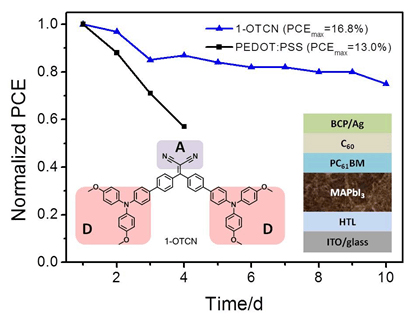摘要/Abstract

设计合成了三种以(甲氧基)三苯胺为给体(Donor,D),苯环为共轭π桥,羰基(或双氰基乙烯基)为受体(Acceptor,A)的D-π-A-π-D型有机小分子空穴传输材料1-T、1-OT和1-OTCN.对三个化合物的热稳定性、光物理以及电化学性质进行表征,并将它们作为空穴传输材料运用至钙钛矿太阳能电池中,研究其光伏特性.实验结果表明,通过引入具有不同给(吸)电子能力的基团,可对材料的光电性质进行有效调控.基于小分子空穴传输材料1-T、1-OT和1-OTCN的非掺杂反向钙钛矿太阳能电池器件光电转化效率(PCE)分别为13.0%、14.4%以及16.8%.其中,基于甲氧基和双氰基修饰的1-OTCN电池器件,由于空穴传输层与钙钛矿界面发生更有效的电荷跃迁和收集,电荷复合较少,因此器件性能最佳,1-OTCN的疏水性质使得其对应器件效率和水氧稳定性均优于常用空穴传输材料PEDOT:PSS(PCE:13.0%).
关键词: 钙钛矿太阳能电池, 有机小分子空穴传输材料, 三苯胺, D-π-A-π-D, 非掺杂, 稳定性
Perovskite solar cells (PVSCs) have recently gained much attention for the advantages of low cost and high efficiency. Based on the different device structures, PVSCs can be simply classified into conventional and inverted categories. Compared with the inverted devices, conventional PVSCs generally exhibited higher PCE. Especially, a milestone PCE value of 24.3% was obtained in conventional PVSCs. However, the complexity and high-temperature process in device fabrication further limit their application in flexible and large-scale devices, while the inverted PVSCs can make up the shortcomings of the conventional PVSCs. Commonly, PVSCs devices contain electrodes, electron/hole transporting layers and the perovskite layer. Among the function layers, hole transporting layers (HTLs) play a crucial role in improving the photovoltaic performance of inverted PVSCs. From the materials point of view, the efficient hole transporting materials (HTMs) are mostly inorganic compounds and polymers. On the other side, taking advantages of easy modification, low price, easy preparation and homogeneity in batches, small molecular HTMs afford superior promising in fabricating efficient and stable PVSCs. However, up to date, small molecular HTMs are relatively less explored. To enrich the material species of small molecular HTMs and illustrate their superiorities in constructing stable PVSCs, in this paper, we designed and synthesized three D-π-A-π-D type small molecular HTMs based on triphenylamine (TPA) unit, namely 1-T, 1-OT and 1-OTCN. The optoelectronic properties of these molecules were modified by introducing different electron acceptor/donor groups. Afterwards, employing as dopant-free HTMs in inverted PVSCs, the three small molecules demonstrated distinguished performance. We found that introduction of electron-donating methoxy into 1-T, 1-OT exhibited increased energy levels and hole mobility. On the other hand, the energy levels of 1-OTCN were down-shifted compared to 1-OT, which was attributed from the stronger electron-withdrawing ability of dicyanovinylene group than carbonyl group. Among the devices with new HTMs, 1-OTCN based PVSCs achieved the best PCE of 16.8%, with open-circuit voltage (VOC) of 1.09 V, short-circuit current density (JSC) of 20.13 mA·cm-2 and fill factor (FF) of 78%. Compared with other HTMs, the higher JSC of 1-OTCN based PVSCs was ascribed from more efficient charge transfer and extraction in the interface of HTL/perovskite. Moreover, in contrast with the hydrophilicity of PEDOT:PSS, the hydrophobicity of 1-OTCN contributed to the satisfactory stability of PVSCs.
Key words: perovskite solar cells, organic small molecular hole transporting materials, triphenylamine, D-π-A-π-D, dopant-free, stability
PDF全文下载地址:
点我下载PDF
